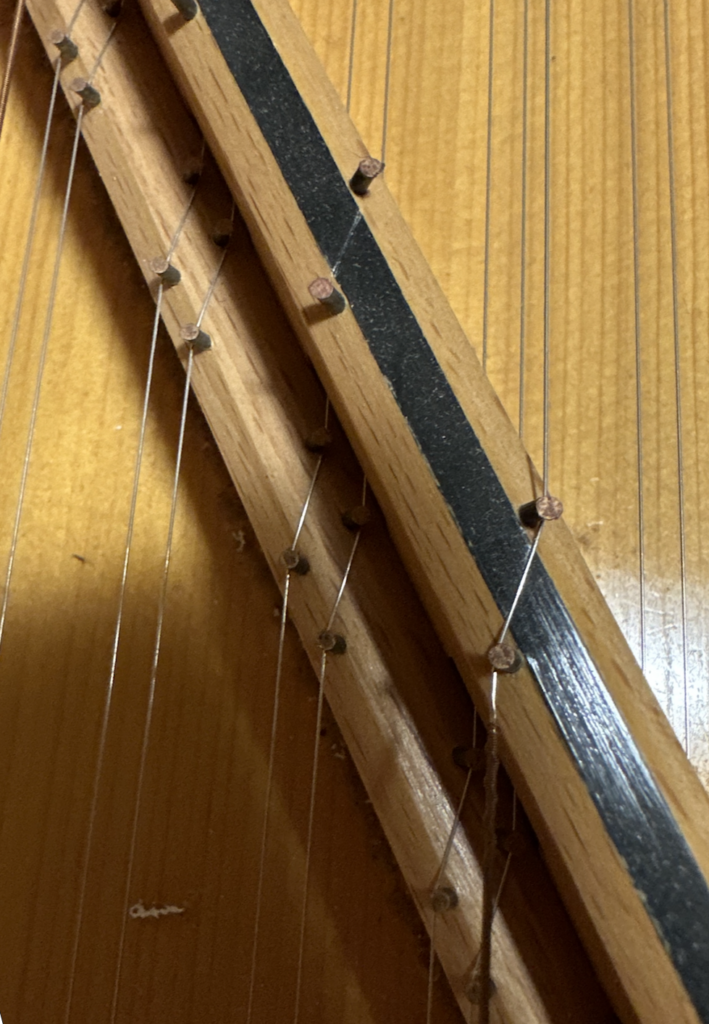The harpsichord is a keyboard instrument which predated the piano by several hundred years. Whereas the piano was invented in the early 1700’s and perfected by the 1800’s, the harpsichord goes all the way back to the middle ages. Harpsichords are incredibly complex and a testament to ancient ingenuity. Servicing harpsichords is very different from working on pianos and thus introduces uniques challenges.
One of the first differences between the harpsichord and the piano is the strings. Harpsichord strings are incredibly thin. So thin they can be hard to see with the naked eye unless light is reflecting off of them. The thinnest piano wire is 29/1000 of an inch or .029″. The thinnest harpsichord wire is 8/1000 of an inch or .008″. That is nearly four times thinner. Because it is so thin it is extremely fragile. The strings break easily and must be replaced often. They are also very difficult to acquire in the United States and often must be acquired from Europe. Replacing harpsichord strings requires several specialized tools shown here which include a harpsichord tuning lever, micrometer, coil lifter, and steel wire cutters.

Harpsichords may contain up to four different string registers. This means that when looking at the strings, there are two levels of two strings each, yielding four strings for any given note. This is visually complex and definitely requires glasses. You’ll notice in the photo that some strings travel above the black area, others below.
The mechanics of a harpsichord are completely different than a piano as well. While they may possess a similar style keyboard, the similarities stop there. Notice that harpsichords often have two keyboards, known as “manuals”. Each keyboard triggers a different set of strings. Depressing a key may strike one or two strings, depending on the instrument design, and the setting of the “stops” which are analogous to organ stops. Borrowing from organ terminology the various string registers are called 8′ (8 foot), 16′ (16 foot), and 4′ (4 foot). These names are confusing because we would expect the strings on the 16′ stop to be 16′ long, which they are not. The 8′ register is considered the default in which A4 is at 440 hz. The 16′ register sounds an octave lower with the A4 key vibrating at 220 hz. The 4′ register sounds an octave higher with the A4 key vibrating at 880 hz. On a pipe organ you would double or halve the length of tubing to raise the pitch up or down an octave, which is where the nomenclature comes from. The player can engage or disengage these strings by using foot pedals as shown here. If you look carefully you can see the names of each pedal written on them.

On some instruments the player will use levers like so. You can see the long brass levers on the right side of the keyboard.
Because harpsichords have a frame which is much less strong than a piano, they go out of tune much more easily. Harpsichords must be tuned often. Some makers like Sabathil have a metal frame but most have a wooden frame. This is in contrast to the piano which has a frame made of cast iron.
Tuning a harpsichord is also rather different from tuning a piano. On a piano, each hammer strikes one, two or three strings depending on whether it is in the bass, tenor or treble section. All the tuning pins for a single note are neatly grouped together. On the harpsichord however, the tuning pins that are associated with a given note are scattered about in a seemingly random order. Some pins are much farther back. Some pins are more to the right and others more to the left. Some pins require slipping the tool in between other strings to reach them. This presents a special problem for the tuner because it is easy to become confused and place the tuning hammer on the wrong pin. If not careful, one could easily break a string. To combat this, harpsichords usually have red felt washers marking the location of each “A” note. This helps the tuner to avoid getting lost. Case in point: do you see all three red washers? They all represent the same pitch A, yet they are in no way lined up.
The tuning lever is quite different as well. Piano tuning levers are very long and have a large tip. Harpsichord tuning levers are very small and have a small tip.
L.A. Piano Tuning is proud to offer a full range of tuning and repair services for harpsichords. Click the link below if you have a harpsichord that needs service.




